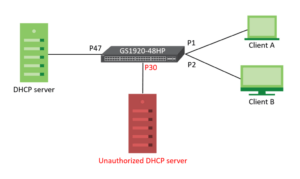
In today’s interconnected world, network security is of paramount importance. One crucial aspect of network security is safeguarding against unauthorized access and malicious activities. Dynamic Host Configuration Protocol (DHCP) guarding plays a significant role in protecting networks from potential security breaches and unauthorized DHCP servers. This article explores the concept of DHCP guarding and its importance in securing your network infrastructure.
Understanding DHCP:
DHCP is a protocol that dynamically assigns IP addresses and network configuration parameters to devices on a network. It simplifies network administration by automating the process of IP address allocation. DHCP operates using a client-server model, where DHCP servers manage and distribute IP addresses, while DHCP clients request and obtain addresses from these servers.
The Threat of Rogue DHCP Servers:
While DHCP greatly simplifies network management, it also introduces potential vulnerabilities. One such vulnerability is the presence of rogue DHCP servers. Rogue DHCP servers are unauthorized devices that distribute false or malicious IP configurations to unsuspecting clients. These rogue servers can lead to various security risks, including IP address conflicts, traffic interception, and man-in-the-middle attacks.
What is DHCP Guarding?
DHCP guarding is a network security mechanism that protects against rogue DHCP servers. It ensures that only authorized DHCP servers are allowed to provide IP addresses and configuration information to clients on a network. DHCP guarding is typically implemented at the network switch level, where it actively monitors DHCP traffic and enforces strict policies to prevent unauthorized servers from operating.
Benefits of DHCP Guarding:
1. Prevention of Unauthorized DHCP Servers: DHCP guarding ensures that only authorized DHCP servers can provide IP addresses, reducing the risk of rogue servers causing network disruptions or security breaches.
2. Mitigation of IP Address Conflicts: By enforcing DHCP guarding, conflicting IP addresses assigned by rogue servers are prevented, which can cause network connectivity issues and potential service disruptions.
3. Protection Against Malicious Attacks: Rogue DHCP servers can be leveraged to launch various attacks, such as ARP spoofing or man-in-the-middle attacks. DHCP guarding helps mitigate these threats by blocking unauthorized DHCP server responses.
Implementing DHCP Guarding:
DHCP guarding can be implemented using various techniques, depending on the network infrastructure and equipment being used. Common approaches include:
1. DHCP Snooping: DHCP snooping is a feature available in many network switches that examines DHCP messages exchanged between clients and servers. It verifies the legitimacy of DHCP packets and builds a binding table of valid IP address and MAC address pairs. Any suspicious or unauthorized DHCP packets are dropped, preventing rogue server responses.
2. Dynamic ARP Inspection (DAI): DAI is a complementary feature to DHCP snooping. It validates Address Resolution Protocol (ARP) packets against DHCP snooping binding information. This prevents attackers from poisoning the ARP cache and redirecting network traffic.
3. Port Security: Port security can be configured to restrict the number of MAC addresses allowed on a specific port, preventing unauthorized devices, including rogue DHCP servers, from connecting to the network.
Conclusion:
In the ever-evolving landscape of network security, DHCP guarding plays a vital role in protecting against rogue DHCP servers and mitigating potential threats. By implementing DHCP guarding techniques such as DHCP snooping, DAI, and port security, network administrators can significantly enhance the security and stability of their networks. By proactively securing the DHCP infrastructure, organizations can minimize the risk of network disruptions, unauthorized access, and potential data breaches.

